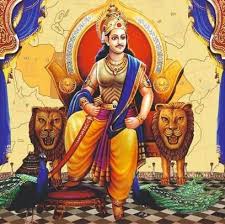Table of Contents
Introduction
India’s historical tapestry is rich with tales of valor, strategy, and grandeur. Among the many ancient India kings, one name that stands out prominently is Chandragupta Maurya. As a foundational figure in the Rise of Mauryan empire, Chandragupta’s early life offers insights into the circumstances. These circumstances birthed one of the greatest empires in Indian history.

Ancient India Kings and Their Legacy
The legacy of ancient India kings is monumental, forming the bedrock of India’s cultural and political ethos. These rulers shaped civilizations, constructed monumental architecture, and propagated philosophies that have lasted millennia. Among them, Chandragupta Maurya emerged as a remarkable leader. He reflected the traits of resilience, wisdom, and strategic foresight. These traits are common among the most revered ancient rulers of India.
The Political Climate Before the Rise of Mauryan Empire
Before the Rise of Mauryan empire, India was divided into several small kingdoms and republics. The powerful Nanda Dynasty ruled Magadha, controlling vast territories. Nonetheless, discontent simmered beneath the surface due to the oppressive nature of the Nanda rulers. This fragmented political landscape created a ripe opportunity for an astute leader to emerge.
Who Was Chandragupta Maurya?
When asking who was Chandragupta Maurya, it is important to recognize that he was a revolutionary figure. His leadership qualities and strategic acumen enabled him to overthrow an entrenched dynasty. He established a new era. Chandragupta was the founder of the Mauryan Empire, the first empire to unify most of India under centralized rule.
The Early Life of Chandragupta Maurya
The early life of Chandragupta Maurya is shrouded in legend and historical speculation. According to some sources, Chandragupta was born into a humble family. He have been of the Moriya or Shudra class. His birthplace was near present-day Bihar. Some accounts suggest he had royal lineage but was raised in modest circumstances due to political upheavals.
Training and Mentorship: Shaping a Future Emperor
The early life of Chandragupta Maurya involved rigorous training under the guidance of Chanakya. Chanakya taught him political science, military tactics, economics, and statecraft. Unlike many ancient India kings who inherited their thrones, Chandragupta had to earn his place through strategy and perseverance.
Rise Against the Nandas
The first significant step in the Rise of Mauryan empire came with the overthrow of the Nanda Dynasty. Chandragupta, along with Chanakya, organized revolts and formed strategic alliances with smaller kingdoms disillusioned by Nanda rule. These events during the early life of Chandragupta Maurya showcased his diplomatic skills and military prowess.
Challenges in Early Life
Despite his later fame, the early life of Chandragupta Maurya was fraught with challenges. Escaping persecution, facing early defeats, and surviving assassination attempts were all part of his journey. Many stories recount how Chandragupta had to spend years gathering resources. He trained armies and waited for the opportune moment to strike.
The Conquest of Magadha and Beyond
After successfully overthrowing the Nanda Dynasty, Chandragupta established himself as the ruler of Magadha. This victory marked the beginning of the Rise of Mauryan empire. His conquest strategies and administrative reforms were revolutionary for the time.
Chandragupta’s Unique Leadership
Understanding who was Chandragupta Maurya involves recognizing his unique leadership style. He was not merely a conqueror; he was an organizer and a visionary. Chandragupta established a centralized government, finished with a complex bureaucracy and a standing army.
Legacy Among Ancient Rulers of India
Among the ancient rulers of India, Chandragupta Maurya’s legacy is unparalleled. His empire stood as a beacon of power, culture, and prosperity for generations. Chandragupta’s success in uniting a fragmented India under a single administration had far-reaching consequences for the subcontinent’s future.
Final Years of Chandragupta
The early life of Chandragupta Maurya was marked by struggle and ambition. His later years were characterized by spiritual pursuit. After abdicating the throne in favor of his son, Bindusara, Chandragupta retired to Karnataka, where he embraced Jainism.
Conclusion
The story of who was Chandragupta Maurya is a compelling narrative of resilience, intelligence, and strategic brilliance. From humble beginnings to becoming one of the most celebrated ancient rulers of India, his journey is deeply inspiring. The early life of Chandragupta Maurya shaped the man. He would establish the Mauryan Empire. He also set standards for governance and leadership in India.
The Rise of Mauryan empire represents a pivotal moment in the history of ancient India kings. It brought about a level of political unity. This era also saw cultural flourishing that would leave an indelible mark on Indian civilization.
FAQs
1. Who was Chandragupta Maurya?
Chandragupta Maurya was one of the most influential ancient India kings. He founded the Mauryan Empire after overthrowing the Nanda Dynasty, unifying most of the Indian subcontinent under a centralized administration.
2. What is known about the early life of Chandragupta Maurya?
The early life of Chandragupta Maurya is believed to have been humble. He was either born into a low royal clan or a modest background near present-day Bihar. His formative years involved training under the guidance of Chanakya, preparing him for his future role as an emperor.
3. How did the rise of Mauryan Empire begin?
The Rise of Mauryan empire began with Chandragupta Maurya’s strategic alliance-building and military campaigns, culminating in the fall of the Nanda Dynasty. His vision and leadership helped unite a fragmented India under one rule.
4. Why is Chandragupta Maurya considered important in Indian history?
Understanding who was Chandragupta Maurya is crucial because he symbolizes India’s early imperial strength and unity. His reign marked the beginning of organized governance and large-scale empire-building in ancient India.
5. What happened to Chandragupta Maurya after he abdicated the throne?
After abdicating in favor of his son Bindusara, Chandragupta retired from political life. Embracing Jainism, he spent his final years in Karnataka, reflecting his shift from empire-building to spiritual pursuits.


